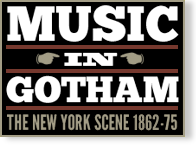Georgia Minstrels
Event Information
Venue(s):
Lina Edwin's Theatre
Event Type:
Minstrel
Record Information
Status:
Published
Last Updated:
18 May 2024
Performance Date(s) and Time(s)
10 Jun 1872, Evening11 Jun 1872, Evening
12 Jun 1872, Matinee
12 Jun 1872, Evening
13 Jun 1872, Evening
14 Jun 1872, Evening
15 Jun 1872, Matinee
15 Jun 1872, Evening
Performers and/or Works Performed
Citations
“Returned from a triumphant tour of England and the Continent.”
“The Georgia Minstrels claim to be actual negroes, and apparently are all they purport to be. Their entertainment, following in the beaten track, is nevertheless marked by a certain racy freedom and freshness of manner—the outgrowth, or, rather, the atmosphere of distinct and peculiar character. The troupe is more numerous than it was when it acted here before, and if its fun be not better than formerly it was, there is more of it.”
“The troupe is composed of negroes varying in hue from the color of the Caucasian race to that of ebony. In the first part appeared fifteen performers, and there were four end men, two bones and two tambos, the former being fair and the latter conspicuous for their excellence of time. The instruments used were two violins, a flute, cornet, violoncello and double bass. Some few of the performers in the first part had their faces made up with burnt cork. Considered as a first class minstrel entertainment, in comparison with white performers, much cannot be said in their praise, but considered purely as an entertainment given by negroes much might be written in its favor. The voices in the quartette do not harmonize, and the music and the singing is fair only. The jokes were not particularly fresh and the utterance of the performers was indistinct. There was one feature in the first part which was novel and deserves high praise, viz., the singing by the entire troupe of ‘Jubilee Carolina.’ It is a refrain and chorus of the style usually heard at African camp meetings. It was thrice encored and created genuine merriment. The olio was decidedly the most enjoyable feature, and did not differ from that usually given at minstrel entertainments. Drewette, attired in female costume, sang some ballads in imitation of a prima donna, which met with favor. He has a good voice. A quartette song and dance by Devonear, Kersands, Smith and Wilson was well performed and elicited considerable applause. Dick Little then gave songs with banjo accompaniment. He has a heavy bass voice which he is unable to control, but his banjo playing was excellent. L. Pierson than sang a ballad which may be classed among the best things on the programme. He was deservedly encored. A sketch called ‘Aunty Clausen’s Soiree’ introduced Bob Height, who evinced the possession of considerable comic ability. He is very tall and slight in figure, and in his dancing, which was excellent, he throws his person into such ludicrous attitudes that the audience was convulsed with laughter. Billy Kersands then attempted some songs attired as the ’swell of the period,’ which were nearly unintelligible owing to indistinct enunciation. He was, however, thrice recalled. A sketch called the ‘Arrival of Mlle. Tostee’ followed, but proved an antique, which gave place to ‘Cornfield Reminiscences,’ which consisted of a dance of the ‘Essence’ style, excellently performed by Billy Kersands, and a plantation festival scene called ‘Sweet Ham Bone’ wound up the performances. The attendance was very large during the early portion of the week, but declined slightly towards the close thereof. Charles B. Hicks appeared as a performer during the first few evening, and after that turned his attention to the front of the house.”

